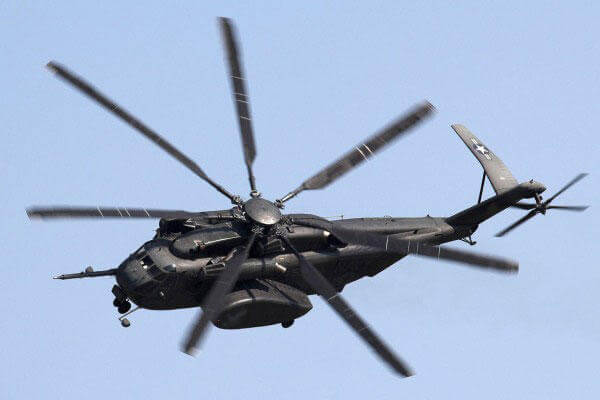The type of U.S. Navy helicopter that crashed Wednesday near Norfolk, Va., killing at least two personnel, breaks down frequently and may be more accident-prone than other kinds of military helicopters, according to interviews and safety data.
An MH-53E Sea Dragon crashed Wednesday in the Atlantic Ocean, about 20 miles off the coast of Virginia Beach, during a training mission. Four of the five crew members were pulled from the frigid water. Two later died and a pilot remains missing.
The Cold War-era helicopter, made by Sikorsky Aircraft, is used primarily to hunt mines. Fully loaded, it weighs about 35 tons. And while it can haul more than any other helicopter -- it can actually carry other choppers -- it needs constant repairs to keep flying, according to a former sailor who maintained the aircraft.
"Those things break so much that hearing something like this is not a shock, which is terrible," he said in a telephone interview with Military.com.
The aircraft also has a higher rate of serious accidents than at least two other types of helicopters, according to statistics maintained by the Air Force.
The Air Force flew H-53 models such as the MH-53 Pave Low from 1966 through 2008, according to data from the Air Force Safety Center. During that period, 23 of the aircraft were destroyed over 519,364 hours of flying. That amounts to a lifetime destruction rate of 4.43 aircraft per 100,000 flying hours.
By comparison, the service's H-1 and H-60 helicopters have lifetime destruction rates of 2.28 and 1.97 per 100,000 flying hours, respectively.
Frans Jurgens, a spokesman for Sikorsky, referred questions about the figures to the Air Force.
In a statement on the accident, he said, "Sikorsky is ready to provide any assistance requested by Navy officials during their investigation. We extend our heartfelt sympathies and condolences to the families, friends and fellow service members of the brave and dedicated crew involved in this accident."
The aircraft fuselage and tail section have been found. The cause of the crash is under investigation.
When asked during a news conference if he had any concerns about the safety of the helicopter following the accident, Capt. Todd Flannery, commander of the Navy's Helicopter Sea Combat Wing Atlantic, said, "I do not."
The Navy's helicopter accident rates weren't immediately available. But the Navy and the Marine Corps in fiscal 2012 counted at least four accidents involving either MH-53E Sea Dragon or CH-53D Sea Stallion helicopters, two of which were fatal and killed a total of six personnel, according to the Navy's annual mishaps report.
The former sailor who worked as a mechanic and collateral duty inspector on the MH-53 said he wasn't surprised at the news of the latest deadly accident.
This individual previously served with the squadron involved in the crash and requested anonymity to speak freely about his experience.
He said the helicopter's accident rate may be even higher in the Navy than the other services because the Navy uses the aircraft mostly for mine sweeping, a far more mechanically demanding mission than simply transporting equipment and troops. To hunt for explosives underwater, the helicopter is flown dragging a sonar-loaded sled about the size of a Ford F-250 pickup truck across the ocean.
"That's a really big strain on the aircraft," he said. "If you can imagine fighting the winds over the ocean. It puts a lot of stress on the aircraft."
What's more, the older MH-53 lacks modern electronic fly-by-wire controls and sensor technology to help guide pilots and warn them of potential danger, he said.
"When you pull the stick, you're pulling actual metal wires on an engine," he said. "There's not some electronic signal telling the engine to rev up or rev down, or telling the blades to angle up or angle down. It's just a really old system and leads to a lot of mishaps."
He said the helicopter already has the highest ratio of maintenance hours to flight hours of any in the fleet partly because even small jobs, such as replacing a nick on a rotor blade, can take hours of fine-tuning and re-calibrating afterward.
"It's astronomical with the MH-53," he said of the figure. "It's the highest of any aircraft the Navy has, and it far out paces the second."
He said he never flew in the helicopter without encountering some kind of problem. Indeed, his best honors in the Navy are related to getting the helicopters flying again. He received a medal once for changing a couple of rotor blades that almost fell off during a mission.
The aircraft involved in the Jan. 8 accident was part of Helicopter Mine Countermeasures Squadron 14, or HM-14, based at Naval Station Norfolk, one of two such squadrons that operate a combined total of almost 30 MH-53s. It was conducting what the Navy described as a routine mine countermeasure training exercise at the time of the crash.
The aircraft ran into trouble around 10:45 a.m. and sent out a distress call before plunging into the 41-degree water. As a second MH-53 provided immediate support, the Navy dispatched two rescue helicopters to the scene. While the seas were relatively calm at 1 to 2 feet, the air temperature was 28 degrees.
The four crew members were flown in pairs to Sentara Norfolk General Hospital, where two later died. The Navy identified them Thursday as Lt. J. Wesley Van Dorn, 29, of Greensboro, N.C., also a pilot, and Petty Officer 3rd Class Brian Andrew Collins, 25, of Truckee, Calif., an aviation warfare systems operator.
One crew member was in good condition and another has been released from the hospital. The Navy and Coast Guard on Thursday suspended their search for the missing crew member, whose name is Lt. Sean Christopher Snyder, 39, of Santee, Calif.





























